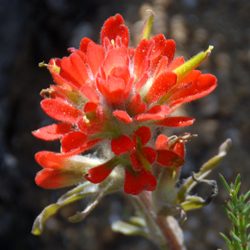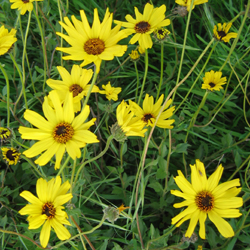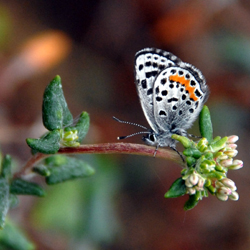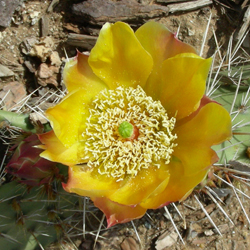Suggestions for Summer Watering
by Dan Songster, CNPS Orange County Chapter

Indian Paintbrush
Castilleja affinis
Advice is always a two edged sword, something that should be dispensed and received with caution. No supposed expert is ever the last word on matters, especially when these issues relate to our wondrous native plants.
One question I have been asked many times is when and how much to water natives—especially in the summer months. Rather than write a book on the subject, I direct you to the recently published California Native Plants for the Garden by Carol Bornstein, David Fross, and Bart O’Brien. The plant descriptions often include good maintenance information.
For our local use, the small but very informative Tree of Life Nursery Catalog gives you much detailed information regarding watering requirements and whether a particular plant has the potential to naturalize in our landscape. If you do not have the catalog, purchase it from Tree of Life Nursery—it has a wealth of information!
There are also some websites that help with watering concepts, mechanics, and other plant information. Tree of Life Nursery and Las Pilitas Nursery have outstanding websites and some water districts have websites with information from general to specific.
Still, here are a few hints on summer watering of natives, a tricky concept to discuss since every gardener has different soils, exposures, techniques, and levels of success that seem to transcend logic. This advice will probably be all right as long as you remember that there are no hard and fast rules that apply in all situations. There is no magic formula for treatment of all native plants.
Now that you have been warned and have read this disclaimer, let us consider some seemingly disjointed factors that may directly influence watering practices during the hot months.
Basic Concepts

California Bush Sunflower
Encelia californica
Where do you live? A Mediterranean climate like ours is mainly affected by proximity to the coast. Very close to coast means cooler summer and fall seasons and less evaporation of water. Sometimes that bit of moisture saved is enough to help a plant through the summer. Inland a few miles? The need for cautious irrigation increases. Riverside? Wow! Lots of evaporation and the need for added water. The more extreme the climate (hot days and cold nights) the greater the need for picking plants that can take those conditions and still do well, without lots of additional summer water. Plant selection becomes key and local natives have an edge. In some of those hot areas the soils are sandy or rocky enough to provide such excellent drainage that root rot is not a large issue, but not always.
Soils: It may not be fair, but clay soils have poor drainage. If you have clay, you may be walking the tightrope that first summer with some plants, trying to water as little as possible and still keep the plant alive. Too little water and the cells breakdown; too much water and root rot pathogens have a chance to attack. Now if you have a mound of decomposed granite, sands, and light gravel, you should find that you can water more frequently without trouble. Establishment of plants in such situations becomes far easier! Owners of such mounds have been seen gazing at a healthy Manzanita and chuckling to themselves. Clay does have some advantages, but better draining soils are almost always preferred.
A few words about Root Rot: Almost everyone’s soil has various species of root rot pathogens swarming around in it, even yours. They aid in the decomposition of sick plants and such, but are also arch enemies of a few of our favorite natives such as Manzanita, Woolly Blue Curls, and Fremontodendron. The pathogen itself can’t do much unless given the right conditions—at which point it can infect and devastate your favorite plant seemingly overnight. What conditions do root rot pathogens need? Warm, moist soils—preferably heavy soils. And if you have natives planted in clay-based soils and it’s summertime and you water, what do you have? A prime hunting ground for the various plant-killing fungus pathogens. And since you cannot change the soil you have (well, not really—go back to Soils), you must try to limit summer water for those natives that are sensitive. Or, take the reasonable road and plant only natives that are not susceptible to the root rot pathogens and can therefore tolerate some summer water. (I’m afraid I am not reasonable in this regard; I must have Fremontia and Manzanita.)
Root to shoot ratio: Lush growth in late spring can lead to summer trouble. Even if plants are able to handle more water than they need without root rot pathogens attacking, their young root systems may not be able to provide enough water for all those leaves, especially during hot summer months. Let’s say you provide generous watering for your new Chaparral Currant (Ribes malvaceum) through spring and into early summer. It grows fine, does not rot away—in fact it puts on a proud amount of lush foliage. The proportion of root mass to foliage is called the “root to shoot” ratio. Envision a small root system, only slightly larger than the root ball you planted in November, with just a few adventurous roots probing more than half an inch into the surrounding native soils. Also envision the above ground portion of the plant—a pleasure to the eye, twice or three times its original size when you installed it just a few months ago, due in large part to your generous spring watering. You may have a problem. Why? Most water leaves a plant in one way—evaporation from leaf surfaces. There are other factors to consider, humidity (or lack of), wind, and exposure to sun, but basically, the more foliage there is the more water a plant loses and therefore the more water it must have to stay alive. If that moisture is not provided, cell structure breaks down and leaves and even small stems are abandoned, drying and dying. Sometimes a plant will put out new leaves and if water is made available, may survive. But more often with young plants, that first big shock is too much and the plant never recovers. So, since a rather small root system cannot really support a large amount of foliage easily, you will notice it wilting dramatically on a summer’s afternoon. You water it and the plant may respond well—or not. Either way, a moderate rate of growth is a better way to grow a healthy plant.
Other Considerations

Seacliff Buckwheat (hosting male El Segundo Blue)
Eriogonum parvifolium
When did you plant? Hopefully in the late fall or early winter, giving your new native the best possible start towards life in your garden by allowing roots to penetrate surrounding soil just a bit before summer hits. Those small silvery-white root hairs moving outward from the original root ball mean a great deal when considering a new plant’s abilities to gather water. Note: Planting in spring is actually OK for a large number of riparian species, some oak understory material, and many of the cultivars whose origins are the central and north coastline (a surprising number!). I have also planted many plants from the Coastal Sage Shrub community in spring with fair results, but generally most of these plants do better with a fall or early winter planting.
Where did the plant originally come from? There are many plants that do fine with summer watering. Consider what plant community your plant came from and that can sometimes tell you a lot about its watering requirements. Plants from Riparian, Redwood, Mixed Evergreen Forest, North Oak Woodlands, and even several of the Foothill Woodland species do fine with some summer watering. Even many of the Coastal Sage Scrub plants survive summer watering. Watering a young Sage, Buckwheat, Lemonade Berry, or Bladderpod once or twice a month that first summer is expected (and appreciated). Some Chaparral plants are not bothered by some water during summer (Mountain Mahogany, Toyon, Ceanothus); while others such as Manzanita, Woolly Blue Curls, or Fremontodendron, are extremely sensitive to fungus pathogens and can perish from a single summer watering. With such plants you should strive to limit watering in summer, especially in the heavy clay soils, and after the first year avoid summer water entirely unless they are planted in that heaven of perfect drainability mentioned above in Soils.
How old is the plant? A plant that has been in the ground for a few years is less likely to need much summer water than a new plant. The root system has grown and is more able to obtain enough moisture from the soil to make it through the summer. That does not mean you would deliberately withhold water from natives that appreciate summer watering. Deergrass, Douglas Iris, Yarrow, and many others can make it through summer without irrigation but look more attractive with that added water. Of course, on becoming familiar with the natives you have, you will find out whether a little summer water keeps your plant looking fresh or if such watering creates problems. Ask people who also grow natives!
Mulching benefits: As long as it is kept a few inches away from the plant’s main stem or trunk, mulch is highly desired in reducing water evaporation from the soil. There is the added benefit of keeping the soil temperatures somewhat balanced, the mulch acting as an insulating blanket, preventing extremely hot or cold soils. These more moderate soil temperatures mean longer periods of root growth, allowing the plant to gather more of its own water without you needing to get out the hose.
Planted in the ground or in containers? Normally, plants in the ground have less need for watering than plants in containers. The very fast draining soils used in pots and the drain holes in the bottom mean that even with a shallow tray underneath water runs past the roots and out the bottom rather fast. While this helps prevent root rot issues, it does mean a plant can dry out much more quickly. These plants may need daily water in the summer.
If you must water, what time of day is best? Generally the coolest time of the day, early morning or even late evening is the best time to water. If there is a day you “know” (or the weatherman claims) will soar into the 90s then wait, if possible, for a day of lower than normal projected temperatures. To improve the success rate with watering natives, do it infrequently, at the coolest time of day (early morning is best), on days that are expected to be cool, and as a deep soaking accomplished by a slow drip. Note: If you have some new native plants requiring that little extra watering to get through the first summer, don’t turn on the entire irrigation system and don’t program your entire system to come on more frequently! Water those new plants individually with a hose.
Conclusion

Prickly Pear
Opuntia oricola
Talk to people: If you read this and are more confused than ever, my apologies. In that case ask someone who also grows natives and you will usually find them willing to share experiences and knowledge. This is perhaps the best way to improve your native garden in many ways. Don’t know anyone who grows natives? Go to the state website at www.cnps.org and click on the “Growing Natives” discussion board. Various competent people answer questions thoughtfully there. You can also attend our chapter meetings and talk to people about particular problems you are having. Don’t be shy—chances are someone has encountered and overcome the same problem.
Determine which plants you have that are most sensitive to summer water and remove drip emitters (if you have them) from the area after the first summer. Also be sure that a neighbor’s irrigation runoff cannot collect nearby and that family members coming out to spritz the garden understand that those plants are to stay dry in summer months. The staggering beauty of a fully flowering Flannel Bush is a sight to see—by all means protect it from unwanted summer water!
Fear is the enemy, knowledge your friend: Don’t feel thwarted by the possibility of a plant not doing well if you water too much or too little; learn what you can and give it a try! You won’t be sorry and you will learn as you go with far fewer losses than I may have caused you to envision.
Get to know your garden: Unlike conventional landscapes demanding copious amounts of water at most times of the year, a native landscape asks that you get to know its citizens and its seasonality and not provide what it cannot use. Realize that the summer downtime most natives enjoy is also a respite for you. As seeds mature through the summer into fall, leaves of the Buckeye drop in summer dormancy, and bulbs sleep beneath a cover of native grasses, take a break yourself and enjoy a garden in seasonal transition.
Re-printed with permission of Dan Songster, CNPS Orange County Chapter
